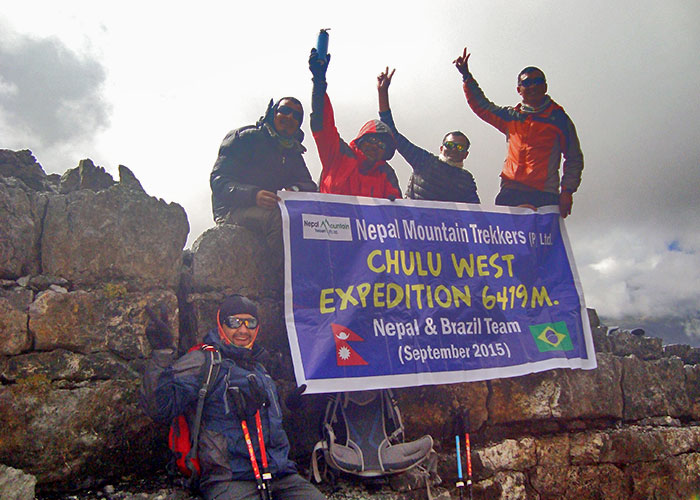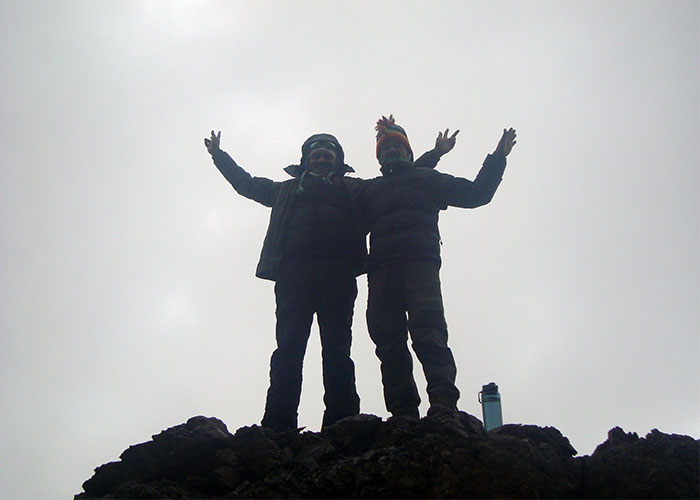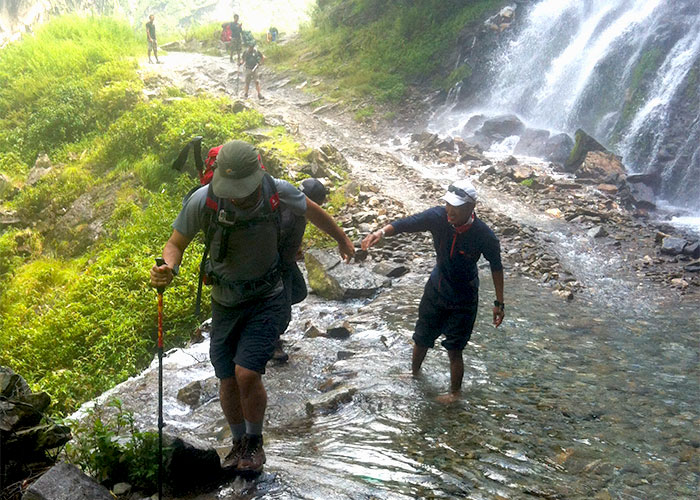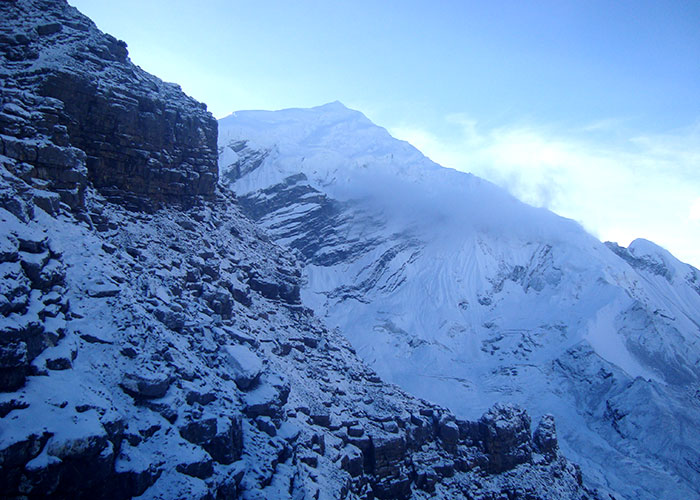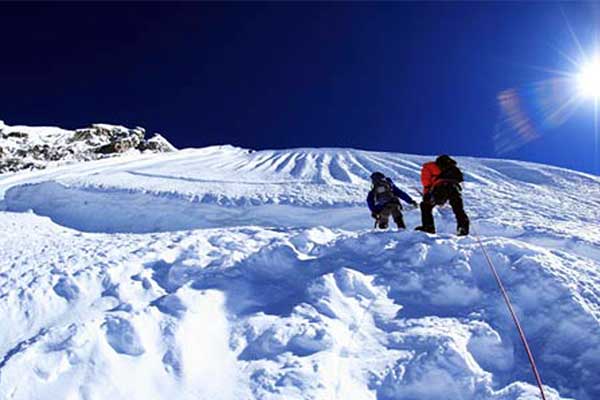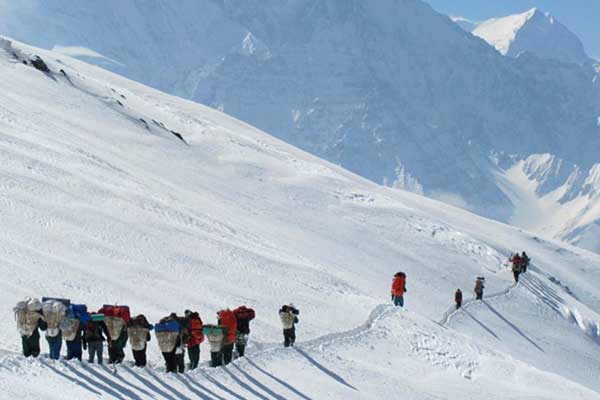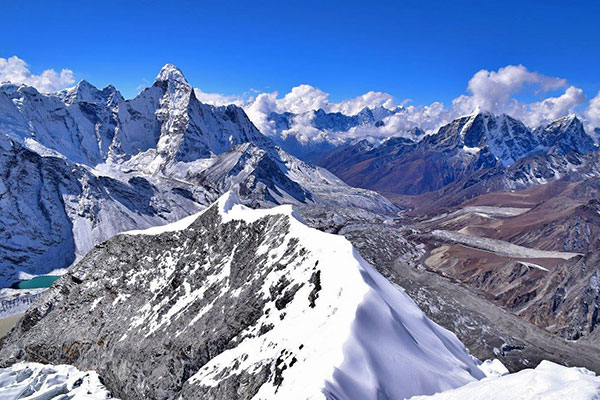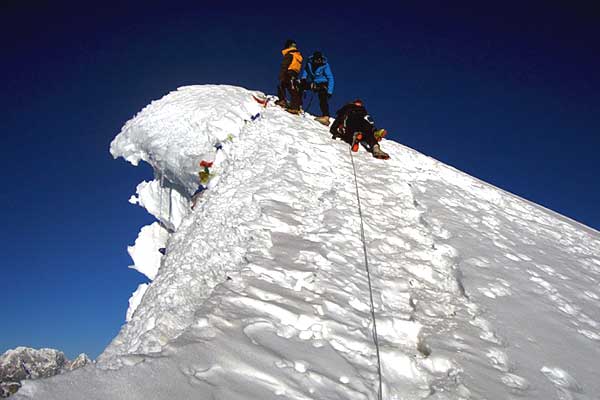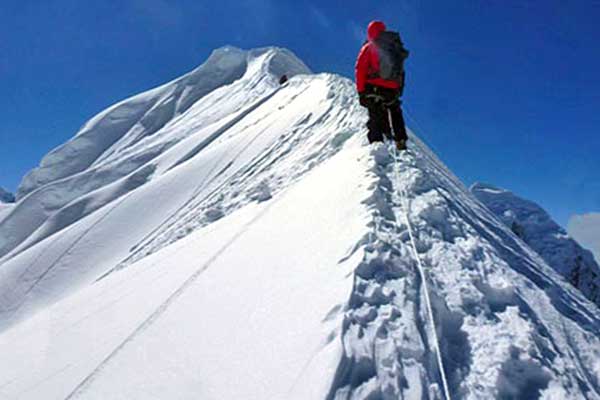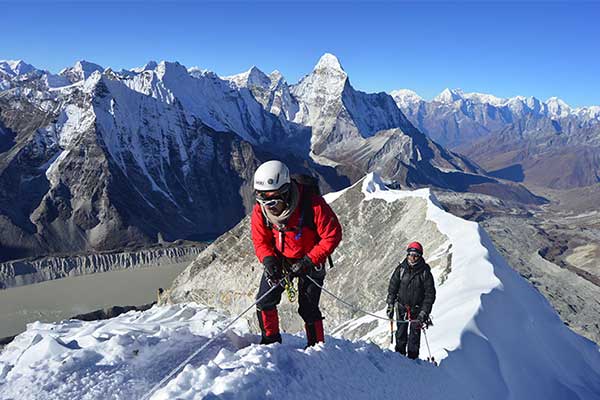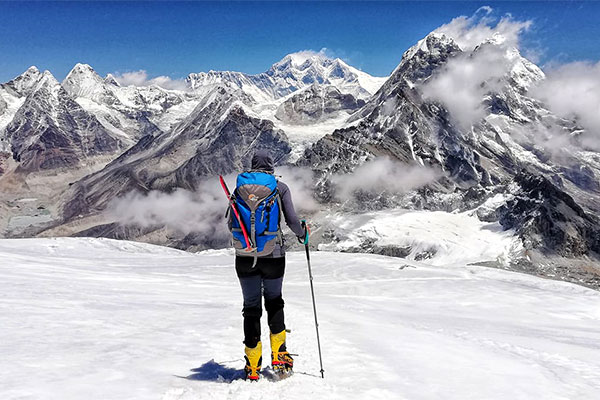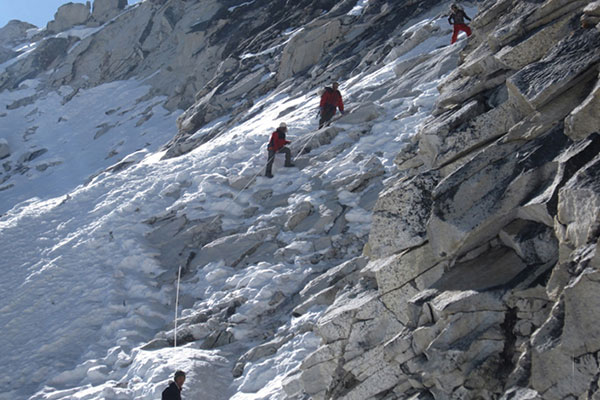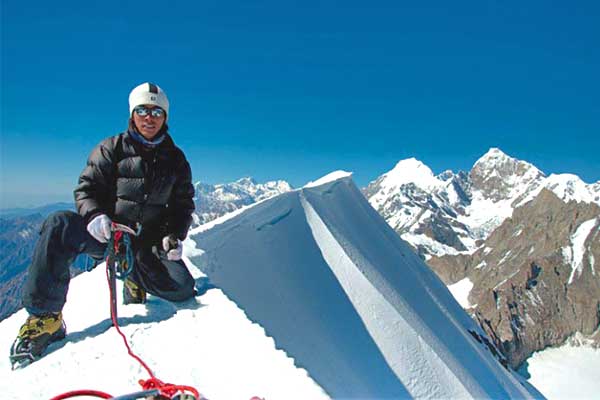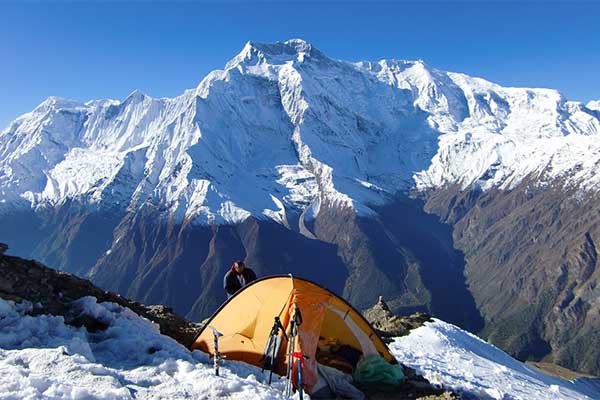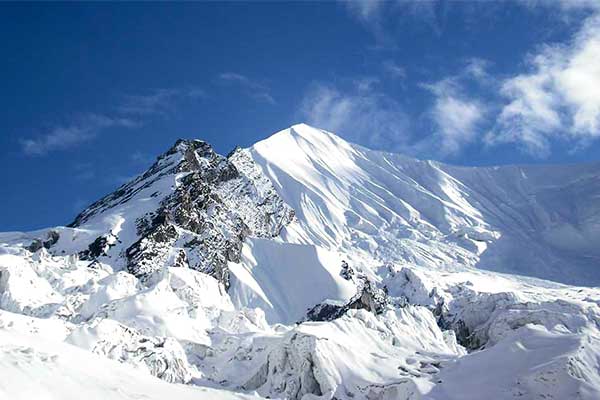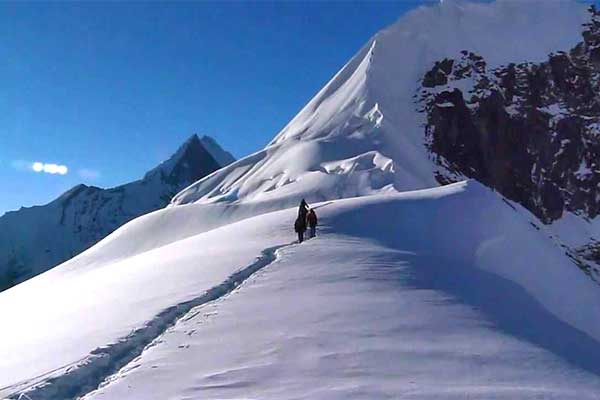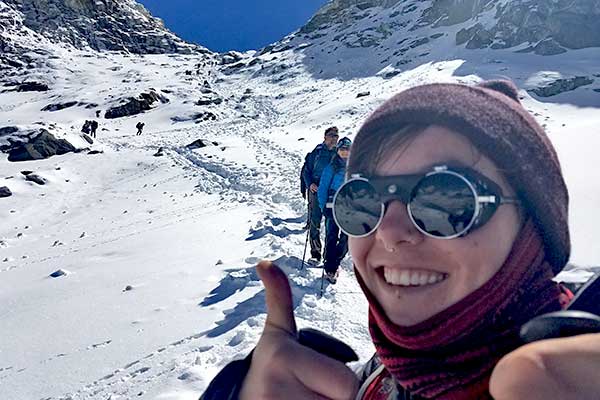Overview
Duration :
19 days
Secondary Activity:
Nature and Culture
Max altitude :
6,420 m/21,062 ft
Transportation:
Private Vehicle and Domestic Flights
Trip ends in:
Kathmandu
Accomodation:
Lodge and Tent Camp
Primary activity:
Trekking and Hiking
Group Size:
Min. 1 pax
Country:
Nepal
Trip starts from:
Kathmandu
Diffficulty:
Strenuous Plus
Meals:
Nepali and Continental
Best Season:
Autumn and Spring
Trip route:
Kathmandu-Syange-Dharapani-Chame-Pisang-Manang-Ledder-Chulu West Base Camp-Chulu west peak High Camp-Chulu west summit -Thorung Phedi-Muktinath-Kagbeni-Jomsom-Pokhara-Kathmandu
Trip introduction
Chulu West Peak Climbing offers a great opportunity to fulfill your wish of trekking and summiting a peak in the naturally blessed Annapurna region of Nepal. Among the two climbing peaks, Chulu east and the Chulu west; we are now talking about the Chulu west peak standing tall above 6,410 meters. During our Chulu west peak climbing journey an excellent view of Annapurna Himalayan ranges with cultural exploration and challenging adventures are on offer.
Overview of Chulu West Peak Climbing
We begin our journey towards the summit of Chulu West as you arrive at Kathmandu, do the necessary preparations, and drive to Syange on a private jeep. From Syange, we start trekking towards the beautiful villages of Dharapani, Chame, and Pisang and enter into the highest valleys of Manang. For proper acclimatization and getting familiar with the surroundings, we spend two nights at Manang. From Manang, the trekking journey continues towards Ledar, and finally, we set up a camp at Chulu West Base Camp. Our professional climbing leaders will provide you with detailed instructions on using peak climbing equipment like ice axes, crampons, and ropes.
In the next couple of days, we push for the summit of Chulu west walking through glaciers. The climb is straightforward. Previous peak climbing is recommended but not mandatory. We ensure your 100% safety during the entire period of the trip. After a successful summit attempt, we join the popular route of the Annapurna Circuit; crossing the famous Thorong La Pass and pilgrimage site Muktinath to Jomsom. From Jomsom, we catch a flight to Pokhara and then by bus to Kathmandu.
Who and how to join this activity?
The most favorable seasons for Chulu West Peak Climbing are during the spring months of March, April, and May, and the autumn months of September, October, and November. During these times the weather will be perfect with very fewer chances of rain. Therefore, be fit and get ready for your next trekking and peak climbing adventure in the Annapurna region of Nepal. Contact us for further inquiries.
Special Note:
If this itinerary doesn’t suit your requirement or if you want to customize it, please feel free to contact us. This trek could be customized as per your required time frame and budget limits.
Overview
-
Day 1Arrival Kathmandu and Transfer to hotel:
-
Day 2Permit Preparation and Equipment Arrangement:
-
Day 3Drive from Kathmandu to Syange by private jeep:
-
Day 4Syange to Dharapani (1,943m/6,375 ft): 6-7 hrs:
-
Day 5Dharapani to Chame (2,713m/8,900 ft): 6-7 hrs:
-
Day 6Chame to Pisang (3,185m/10,450 ft):5-6 hrs:
-
Day 7Pisang to Manang (3,351m/10,994 ft): 5 hrs:
-
Day 8Manang: Acclimatization Day:
-
Day 9Manang to Ledar (4,210m/13,812 ft): 6-7 hrs:
-
Day 10Ledar to Chulu West Base Camp (4,900m/16,072ft): 4 – 5 hrs:
-
Day 11Chulu West Base Camp: Rest and Climbing Preparation Day:
-
Day 12Chulu West Base Camp to Chulu West Peak High Camp (5,100m/16,728ft): 4 – 5 hrs:
-
Day 13Chulu West Summit (6,420m/21,062ft) overnight at Chulu West Peak Base Camp: 9-10 hrs (depends on your fitness):
-
Day 14Chulu West Peak Base Camp to Thorong Phedi (4,500m/14,763 ft) or High camp: 5-6 hrs:
-
Day 15Thorong Phedi / Thorong High camp (4,800m/15,748ft) via Thorung La (5,416m/17,769ft). Trek to Muktinath (3,802m/12,473ft): 8-9 hrs:
-
Day 16In the morning Muktinath Temple excursion and trek Kagbeni (2,800m/9,186ft): 3-4 hrs:
-
Day 17Kagbeni to Jomsom (2,720m/8,923ft): 2-3 hrs:
-
Day 18Jomsom by flight to Pokhara. Excursion around Pokhara valley with own activities. Overnight at Hotel:
-
Day 19Fly/Drive Pokhara to Kathmandu. Excursion around Kathmandu valley with own activities:
-
Day 20Departure Day:
Detail Itinerary
Day 1 : Arrival Kathmandu and Transfer to hotel::
Upon your arrival at Tribhuvan International Airport (TIA) in Kathmandu, you will be welcomed by our representative after you complete the formalities at the customs of the airport. After you complete all the visa formalities, look for our representative outside the terminal hall who shall escort you to the hotel in Kathmandu where you shall take a rest. Relax at the hotel after a long travel to this beautiful nation. Later in the afternoon, you may stroll around in the streets of Thamel or stay at the hotel which depends upon your interest and condition at that time. Enjoy the authentic cuisine and experience the warm hospitality at the hotel that shall introduce you to the richness of Nepalese food culture. Stay overnight in Kathmandu.
Day 2 : Permit Preparation and Equipment Arrangement::
In a day before moving to the trekking destination, today we shall get ready all the trekking and climbing permits necessary during our expedition, including climbing permits, ACAP permits, and others. Check whether all the equipment needed during the trek and climbing is ready and in perfect condition. Go shopping if you find any gears and equipment missing. We shall have a pre-trek meeting where you shall be briefed about the trekking and climbing to the Chulu West Peak. Take on this opportunity to clarify any queries related to trekking and climbing. Optionally, you may also have the sightseeing and exploration around the Kathmandu valley including the historic royal palaces, temples, monasteries and stupas, old statues, and other evidence of historical importance. Nevertheless, we shall have an excursion around Kathmandu valley at the end of this expedition. Stay overnight in Kathmandu.
Day 3 : Drive from Kathmandu to Syange by private jeep::
We begin our expedition today with the drive to Syange, the starting point of our trekking and climbing. We start early today as the journey today shall be a long one as we are to go 130 km west of Kathmandu valley. The road to Besisahar is a fairly good road that is coal-tarred while the road after that is dusty and bumpy which may pose some discomfort to the travelers. However, the length of the journey shall pass away with ease as you shall have the opportunity to witness rural Nepal during the drive. Lush and green hills and valleys, torrential and fast-flowing rivers, villages with traditional lifestyles fairly undisturbed by modern developments, terraced farming, and a pleasant view of the beautiful snow-capped mountains en route shall be the highlight of today’s journey. Stoppages during the drive shall provide you with the chance to interact with the welcoming locals. Stay overnight in Syange at the guesthouse.
Day 4 : Syange to Dharapani (1,943m/6,375 ft): 6-7 hrs::
In the trekking today we shall meet the local inhabitants who migrated from Tibet a very long time ago and enter into the mysterious yet enchanting Mustang region. The trek starts from Syange and with the company of the mighty Marsyangdi River and after an hour of uphill trekking, you shall reach Jagat. Continue the trek ahead along the steep trail and leave behind the beautiful view of the river below the village and the attractive waterfall across the river. Trek along the trail and pass through the settlements of Chamje, Ghatte Kholagaon, Chamje, and Sattale, have the view of lush valleys and hills, get along with long hot climb and cultivation fields to reach Tal village after which we enter Mustang district. Ahead of Tal, the trail rises steeply for some time, takes a dip, and rises again on the high hills to take us to Dharapani. Marshyangdi River continues its roar while we trek past the Mani walls, cross some suspension bridges and traverse through smaller settlements as we reach Dharapani. Besides interacting with the Tibetans and Gurung communities at Tal village, you shall also experience the uniqueness of their culture. Stay overnight in Dharapani.
Day 5 : Dharapani to Chame (2,713m/8,900 ft): 6-7 hrs::
Today we shall leave Dharapani, one of the biggest villages in Manang district, and move further deep into the region. The trek today has mostly climbed as we are slowly moving to higher altitudes. From Dharapani, the trail passes through schools and makes an ascent to a hill, and then descends to Bagarchhap within an hour of trekking. Experience the Tibetan culture in this village which has a monastery, gompa decorated with prayer wheels, and buildings reflecting Buddhist culture. Moving ahead through the narrow forested gorge and past the view of the waterfall, we reach another Tibetan village of Danakyu. Proceeding ahead, we shall now enter into the region with dense forest, cross small tributaries, trek past waterfall and walk over steep stones and traverse through a couple of Tibetan settlements such as Thanchow and Koto to reach the destination for today, Chame. Chame is also the administrative headquarters of the Manang district. En route, you can have a splendid view of mountains such as Annapurna II and some other peaks in the Annapurna range. Stay overnight in Chame.
Day 6 : Chame to Pisang (3,185m/10,450 ft):5-6 hrs::
We leave Chame on a trail with suspension flag-festooned by prayer flags and trail with stone steps and in a steep narrow trail through dense forest, you reach the curved rock face which lies high above the river. From this spot the scenery you witness is just beyond description. In a trail that has several ups and downs, you traverse through the settlement of Talkeu after 40 minutes and then to a settlement inhabited by the Khampang community historically, the village of Bartang. Ahead of this traditional boundary between the Manang area to the north and the Gurung area to the south, trekkers may follow the trail accompanied by River and ascent to Manang valley and Lower Pisang after crossing a river or they may take on the trail to Upper Pisang which is more scenic. The choice is made by the trek leader during the trek. You can experience a change in landscape and vegetation, where the terrain becomes arider and vegetation sparser, and spectacular Rockwall overlooks the trail. Stay overnight in Pisang.
Day 7 : Pisang to Manang (3,351m/10,994 ft): 5 hrs::
From Pisang, the trail now enters into the dry and arid region of Manang district which falls in the rain shadow areas thereby receiving scanty rain in the summer and snow in the winter season. The trail rises gradually at first and more steeply from Lower Pisang to reach the ridge overlooking Manang valley. The trail then goes down to the flat valley floor and crosses the Sabche River with the view of Annapurna II and IV, and reaches the vicinity of Braga village. Another trail from Upper Pisang takes trekkers through Ghyaru, Ngawal, and Julu to reach Munchi which leads to Braga. En route, you traverse past Mani walls, monasteries and Chortens, and the famous Sher Gompa before Munchi. Ahead of Braga village trekkers move past some other gompas, Chortens, and other heritages to reach the dry and windy atmosphere of Manang. The views of majestic Annapurna, Pisang Peak, and other mountains make the trekking much more entertaining. We may also pay a visit to the largest monastery in Manang, the Barge Monastery. Stay overnight in Manang.
Day 8 : Manang: Acclimatization Day::
To help our body adapt to the lower levels of oxygen with the increase in altitude and avoid the risk of several consequences of this lack of sufficient oxygen, today we shall acclimatize in Manang. On this day, however, trekkers shall go for some short hikes around the valley to the higher altitudes. The destinations for a day hike around Manang are the Bhojo Gompa, Gaganpurna Lake, the small and old monastery at Braga, and the office of the Himalayan Rescue Association to get information on altitude sickness. If you have trekked the route of Upper Pisang, you will get some aid in this process of acclimatization. This day of acclimatization shall make your body adapt to the next couple of days’ rapid ascent over the challenging Chulu West Peak. Exploring the surrounding areas of Manang, stay overnight in Manang.
Day 9 : Manang to Ledar (4,210m/13,812 ft): 6-7 hrs::
Today we shall be trekking to Ledder in a gradual manner as we shall be focusing on the acclimatization as well. The trail continues through the alpine landscape and vegetation, pine forest to reach the destination. Past Manang the trail initially goes steeply to the last round-the-year settlement before the Thorang La Pass, the village of Tengi. After a short ascent, you reach Ghunsang, a village with an amazing viewpoint of mountains and a beautifully arranged teahouse. Through the trail with Mani walls, small tea shops, and a bridge over a small rivulet you shall ascent to Yak Kharka, the village with open pasture lands for the Yaks. Our destination Ledder is reached by crossing another glacial stream and through the landslide-prone areas in a trek with a gradual ascent. Stay overnight in Ledder, a place surrounded by alpine trees and vegetation.
Day 10 : Ledar to Chulu West Base Camp (4,900m/16,072ft): 4 – 5 hrs::
A few days from today, we shall be preparing for the climb over Chulu West Peak. Today, the destination of this trek shall be the base camp of Chulu West Peak. The ascent to base camp isn’t technical but the high altitude makes the climbing bit strenuous. Proceed slowly along the trail through the rocky trail and reach the amazing scenery of the base camp. Annapurna massifs look majestic and beautiful from the Chulu West Base Camp. We shall set our tent in the base camp and end the day with the sight of an amazing sunset over the Annapurna range. Stay overnight in the tent at Base Camp.
Day 11 : Chulu West Base Camp: Rest and Climbing Preparation Day::
This shall be a very important day before we attempt to climb over the Chulu West Peak. Today as well we shall be at the base camp; however, we shall be training here for our ascent. The climbing leaders shall prepare you further for the use of various equipment such as an ice axe, crampons, ropes, and others which shall be useful during the ascent. Check your equipment once again to make sure you avoid any problems due to any defect in the equipment. For the training, the climbing leader may take you higher from Base Camp as well. After preparing yourselves for the summit, return to the tent and get proper rest. Stay overnight at Base Camp.
Day 12 : Chulu West Base Camp to Chulu West Peak High Camp (5,100m/16,728ft): 4 – 5 hrs::
The ascent on the slopes of Chulu West continues as we move higher up from the Base Camp. Though the ascent to High Camp is not much technical we may need to use crampons, ropes, and ice axes due to the rocky and icy surface of the slope. The expert members of the crew fix the ropes in the steep and difficult sections as other climbers prepare to stay overnight in the High Camp. Staying in the High Camp helps the climbers make a relatively relaxed climb to the peak and assists in acclimatization, though some climbers attempt to summit starting from the Base Camp as well. Stay overnight in Tent in High Camp.
Day 13 : Chulu West Summit (6,420m/21,062ft) overnight at Chulu West Peak Base Camp: 9-10 hrs (depends on your fitness)::
The ultimate adventurous day arrives as you shall be conquering the Chulu West Peak. On this long, strenuous yet triumphant day, we shall start early around the daybreak. On this icy trail, we ascent slowly and gradually to catch our breath and enjoy the marvelous views of the Himalayas. Use of ropes, crampons, and ice axe are needed during the ascent. Once at the top, you shall be feeling like never before; the feeling of joy and triumph, achievement and accomplishment combined with the marvelous and panoramic sight of the mountains such as Annapurna II, Annapurna IV, Gaganpurna Peak, and Lamjung Peak is outstanding. After capturing these blissful moments, we shall return gradually to the base camp. Stay overnight in Chulu West Peak Base Camp.
Day 14 : Chulu West Peak Base Camp to Thorong Phedi (4,500m/14,763 ft) or High camp: 5-6 hrs::
After the successful ascent of the Chulu West Peak, we shall now head for the base of challenging Thorong La Pass. Retracing back the trail leading to the base camp we go back the same trail till Ledder and then trek in the northern direction towards the challenging pass. During the trek towards the pass, you get to cross several small streams flown out of the Chulu East and Chulu West peaks and trek past some landslide-prone areas besides some sparsely located tea shops. After the trek of around 6 hours, you shall reach the base of the pass known as Thorung Phedi. Depending upon the fitness level, interest, and other circumstances trekking guide may decide to trek higher up to the High Camp. Stay overnight in Thorung Phedi or High Camp.
Day 15 : Thorong Phedi / Thorong High camp (4,800m/15,748ft) via Thorung La (5,416m/17,769ft). Trek to Muktinath (3,802m/12,473ft): 8-9 hrs::
Today we shall have another challenging day of our trekking beside the summit of Chulu West Peak a few days earlier. Starting from the Thorung Phedi, the first section of the trail is very steep as the trek from base camp to high camp ascents to a higher altitude in a quick fashion. The trail then eases out as we approach the top. Though the trail eases out after an initial steep phase, the higher altitude still makes it difficult for the trekkers. After trekking for about 4 hours and crossing numerous false summits, trekkers reach the top of the Thorung La Pass (5,416m/17,769ft.). The sight from Thorung La Pass, arguably the largest pass in the world, is marvelous. Trekkers get to witness the view of majestic peaks of the Annapurna range, the beautiful valleys, and gorge formed by the torrential Kali Gandaki River, and the snow-capped peaks to the far in Tibet. After spending some time at the summit of the pass you shall then descend from the pass, slowly and gradually. Though the trail from the pass is gentle at the beginning, it turns out to be steep and winding in several sections until it reaches the grassy slopes at the foothills of the challenging pass. Ahead of the foothills of the pass, the trail leads us to the settlement of Chaharu past the ruins of Yak Herder’s nest, and then to the holy pilgrimage of Muktinath. Stay overnight in Muktinath.
Day 16 : In the morning Muktinath Temple excursion and trek Kagbeni (2,800m/9,186ft): 3-4 hrs::
Get amused at the beauty of the region and the exemplary religious harmony displayed at the Muktinath Temple, the temple of Hindu God whose name means “God of Salvation” in Hindu and “Nirvana” in Buddhism. Prayers are made to the god by both the Hindus and the Buddhists; there are temples and gompas in the surrounding areas of the temple and the heritages are dedicated to Hindu and Buddhist deities. The flame ignited due to geothermal heat and the 108 holy taps believed to wash the sins of pilgrims are the other attractions of this sacred destination. We trek ahead of this holy destination, where the pilgrims flock from India as well, and move to another scenic settlement of Kagbeni. The trail ahead starts just ahead of Muktinath Temple and proceeds in a twisting trail through small settlements, several Chortens, and prayer wheels to reach Dzong and further ahead to Putak. Ahead of Putak, you shall walk through the barren landscape and beautiful views of the mountains. As you cross the highest point before descending to Kagbeni the atmosphere gets windy. You reach scenic Kagebeni after you have a short steep descent down a gully. Stay overnight in Kagbeni.
Day 17 : Kagbeni to Jomsom (2,720m/8,923ft): 2-3 hrs::
After trekking in the arid and windy landscape of Kagbeni, today you shall follow the trails of Kali Gandaki River as you are heading for Jomsom. Situated at the Kali Gandaki valley, Kagbeni was once one of the major trade routes between Tibet and India and the fortified arrangement of houses shows the importance of this place in the past heydays. We start early from Kagbeni so as to avoid the strong and dusty wind blowing up the valley in the section between Kagbeni and Kalopani. The trail continues along the Kali Gandaki River and traverses through the ruins of the village, and several lively settlements including Ekle Bhatti. The trail from Ekle Bhatti to Jomsom is an easy trail that takes trekkers through sand beaches formed by the river, some ancient gompas, and other such heritages and along the road that takes people and goods to and from Jomsom to upper areas including Muktinath. Stay overnight in Jomsom, a scenic village that hosts important offices including the ACAP office and Army Mountaineering, some temples, Mustang Museum, hospital, and other establishments.
Day 18 : Jomsom by flight to Pokhara. Excursion around Pokhara valley with own activities. Overnight at Hotel::
The adventure in the enchanting Annapurna region and the once restricted areas of Manang and Mustang, we shall leave for Pokhara. This marks the end of our adventurous trekking. The flight to Pokhara from Jomsom starts early in the day as in the afternoon the weather creates disturbances for the flight to take place. Flying above the contrasting landscapes, above the deepest gorge and the lush valley created by Kali Gandaki River, with the view of glittering mountains including the Annapurna massifs we reach the scenic city and the unofficial tourist capital of Nepal, Pokhara city. After relaxing we shall move in for the excursion around the Pokhara valley. This Lake City has a lot to offer tourists. From the famous Phewa Lake (on clear weather days we can see the reflection of Fishtail Mountain on the lake) to the shy Devis Falls, from the Mahendra Cave named after the former king of the Shah dynasty to the Gupteshwor Mahadev cave with the shrine of Lord Shiva you have many sites to explore. The International Mountaineering Museum provides information on the Himalayas, mountaineering, and the culture of the inhabitants around the valley. After exploring the diverse nature sites, get back to the hotel for your stay. Overnight stay in Pokhara.
Day 19 : Fly/Drive Pokhara to Kathmandu. Excursion around Kathmandu valley with own activities::
This is the final day of this exciting adventure as we head to Kathmandu from the beautiful Pokhara valley. Starting early from this scenic city we traverse through rural villages and landscapes, twisting and turning roads, green hills, small and beautiful waterfalls, a religious site such as Manakamana Temple, torrential rivers such as Trishuli and Marshyangdi as well as the view of the humongous mountains overlooking the trail from far away. After reaching Kathmandu rest in the hotel for some time and head out for the excursion of cultural and historical heritage. Pashupatinath Temple, the sacred and most popular Hindu pilgrimage of Nepal, Swayambhunath Stupa which is the 14th-century heritage and thereby among the oldest stupas in the world, and the Boudhanath Stupa, one of the largest stupas in the world are the star attractions in the valley. The historical royal palaces in Kathmandu and the neighboring cities of Patan and Bhaktapur are the other prominent heritages with temples, museums, intricate carvings, and other crafts.
After exploring the heritages prepare for your flight to the onward destination. Our representative shall assist you by escorting you to the international airport. We hope that you made the most out of this adventure, memories are created strong enough to bring yours for another adventure in this nation. Have a safe journey ahead and keep enjoying the adventure.
Day 20 : Departure Day::
The adventurous, exciting, and entertaining Chulu West Peak Climbing comes to an end today. You may engage in some other activities if you have booked with us or you may go for last-minute shopping. Extend your stay and enjoy other packages if you have enough time for staying in Nepal. You shall be transferred to the airport for your flight to the onward destination by a representative of Nepal Mountain Trekkers. We thank you for being a part of our team and we hope that you have created some of the best memories of your life during this trek. We hope that this nation full of contrasts, diversity, and mysticism has tempted you to another visit to this Himalayan nation called Nepal. Have a safe and happy journey ahead!
Price Includes
- Airport Pick up and drop
- 3 nights Hotel in Kathmandu(Hotel Green Horizon or similar standard)
- All accommodation during the trek in the best hotels/tea-houses in the area (differing according to the price you wish to spend)
- Sanitation: The accommodation we provide will be neat and clean with warm hospitality and quality services.
- Single Accommodation: You won’t have to share your accommodation with anyone else so your privacy is protected.
- All foods during the trek: Breakfast, Lunch, and Dinner; any items on the menu as much as you wish to consume.
- We provide hygienic and safe meals to re-energize you.
- We request you not to waste your meals for it is difficult to transport food in the rural area.
- You are not allowed to share your meals with anyone else from another group.
- All required camping equipment
- Domestic Flights and all required land transportation
- Professional and Highly experienced English-speaking Trekking Guide licensed by the Government. Including their lodging and food.
- Local Staff: Our guides are locals of the region which ensures that you will surely get to explore a bit more during the trek than with any other guides.
- Experienced: With the experience of more than a decade of working in this field, our trekking guides possess excellent knowledge on briefing during the trek as well as they are experts in handling all kinds of critical situations which might occur during the trek.
- Insurance: Nepal Mountain Trekkers have an insurance policy for all our trekking staff.
- Porters (1 porter for 2 trekkers with a max load of 25 KG). Including their lodging and food.
- Local Staff: The porters we hire belong to the same region where we trek in order to provide employment opportunities to the locals as well as to make you explore every prospect of the region.
- Well-experienced ice climbing guide (Climbing service charge, insurance, food, personal equipment)
- Group Climbing gear fixed rope, main rope, ice axe, zoomer, harness, the figure of eight, carabineer
- Four seasonal sleeping bags, down jacket, Nepal Mountain Trekkers duffer bag, t-shirt, and trekking map (Note: down jacket and sleeping bag are to be returned after trip completion)
- Peak Permit Royalty, Annapurna Conservation Area Entrance Fee
- Rescue Arrangement Service
- A comprehensive medical kit
- 13% VAT and 10% service charges
- Farewell Dinner
Price Excludes
- Nepalese visa fee (Visa Information)
- International airfare to and from Kathmandu
- Excess baggage charges
- Lunch and evening meals in Kathmandu
- Extra night accommodation(s)
- Travel Insurance and Rescue Cost
- Personal expenses (phone calls, laundry, bar bills, battery recharge, extra porters, bottle or boiled water, shower, etc.)
- Personal trekking and climbing gears
- Tips for guides and porters
Equipments
 Equipment List
Equipment List
- Duffel Bag
- Day Pack (35-45 L)
- Sleeping Bag (-20F/-30C recommended)
- Down Jacket
- Trekking Boots
- Crocs (evenings & washing)
- Trekking Pants (2-3)
- T-Shirts (3)
- Long-sleeve Trekking Shirts (2-3)
- Trekking Jacket
- Gortex (or similar) Jacket & Pants
- Fleece or Thermal Top (evenings)
- Fleece or Thermal Bottoms (evenings)
- Lightweight Long Underwear (to sleep in or layer under clothes)
- Socks (5)
- Gloves (lighter & heavier for passes)
- Wool Hat
- Baseball Cap or Wide-brimmed Hat
- Camp Towel
- Trekking Poles (optional, recommended)
- Down Booties (optional, recommended)
- Sunglasses (2)
- Water Bottles | Nalgenes (2-3)
- Bladder (optional, recommended)
- Toiletries, Sunscreen with SPF, Lip Balm with SPF
- Watch (with alarm)
- Extra Batteries
- Battery Chargers
- Head Lamp (2)
- Yak Trax (for treks with icy passes)
- Water Purifying Tablets, Small Water Filter or Steripen
- Camp Washing Bowl (optional, collapsible for clothes)
- Laundry Detergent (Kathmandu) or Bio-degradable Clothes Soap
- Hand Sanitizer
- Small Solar Panel (optional, recommended for iPods, iPhones, camera batteries, Kindles)
- Book(s)
- Zip-Lock | Plastic Bags
- Soft Toilet Paper | Tissues (we supply toilet paper but you will want something softer for blowing your nose)
- Baby-Wipes | Wet-Wipes (for personal cleaning)
- Handi-Wipes, J-Cloth, or Chux (optional: easy for a quick daytime clean, fast drying)
- Rehydration | Electrolytes
- Snacks!
- Personal Medical Supplies
- Available in Namche Bazaar
- Snacks, chocolate bars, energy bars (Western brands), dried fruit & nuts
- Laundry Detergent
- ALL trekking gear (Sherpa Gear, Mountain Hardwear, Tsetang’s Gear Shop all have real gear), real & knock-offs.
- Lemon Tang (for water if you want)
- Batteries
- Trekking Poles
- Micro Spikes
- Medical Supplies
- We strongly suggest bringing Western meds with you as there are a lot of Indian fakes on the market!
- Suggested: Diamox, Azithromycin, Ciprofloxacin, Tinidazole, or Flagyl & Augmentin. Bring COMPEED for covering blisters & good tasting electrolytes &/or rehydration salts (Emergen-C is a good American brand). The local versions aren’t very appealing.
- We also recommend bringing strong knee & ankle supports & braces, ACE bandages for sprains & strains, Tegaderm &/or other would coverings. Duct tape is always useful. We’re happy to take excess medical supplies off your hands when you leave if you won’t need them and pass them on to others. We use lots of the large amount we have with us to treat locals we meet when trekking.
Related Trips
You will also like …
